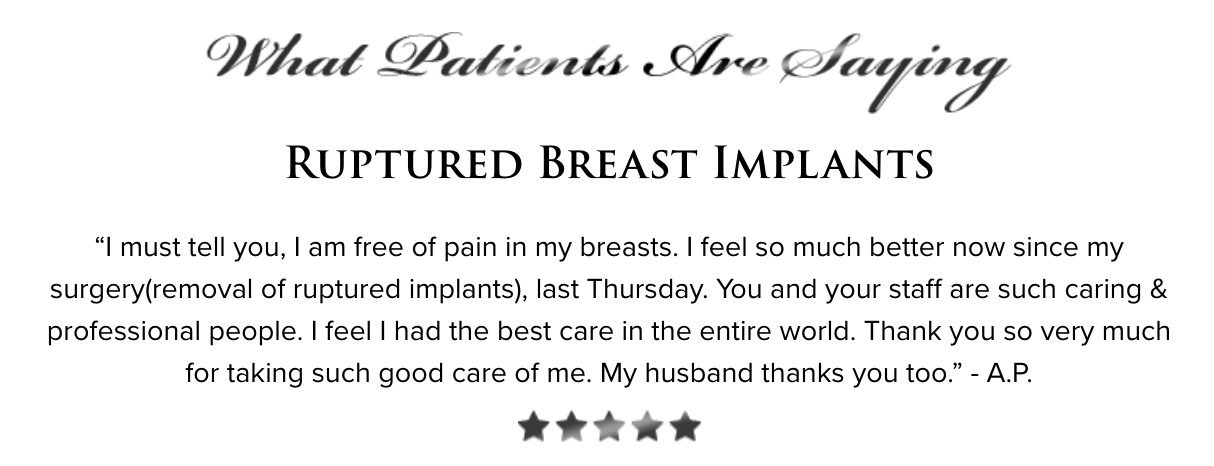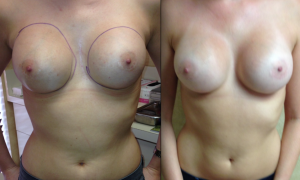When to Replace Your Implants
Posted On: April 10, 2019 Author: The Office of Dr. Stuart Linder Posted In: Breast Implants, Breast Revision, Ruptured Implant
 There is often great confusion regarding when to replace saline and silicone breast implants, especially when associated with ruptured breast implants. Please view this specific page for greater details pertaining to removal and replacement of ruptured saline, silicone, Dow Corning, Becker implants, double lumen, polyurethane implants, and gummy bears.
There is often great confusion regarding when to replace saline and silicone breast implants, especially when associated with ruptured breast implants. Please view this specific page for greater details pertaining to removal and replacement of ruptured saline, silicone, Dow Corning, Becker implants, double lumen, polyurethane implants, and gummy bears.
Saline Implants
With respect to saline implants, patients who have a slow leak may have visible rippling from the implant without a complete rupture. When this becomes evident, and there is asymmetry associated with the leakage and visible rippling, I recommend the implant be replaced. If the implants are greater than five years old, I usually recommend replacing both saline implants at the same time under general anesthesia. For patients who have an obvious complete rupture of the saline implant and the implants are over five years, once again, I recommend bilateral removal and replacement with new saline implants.
For patients who have implants less than five years old, however, and there is visible rippling, wrinkling or rupture, I leave it up to the patient as to whether they decide they want to replace the contralateral breast. Reasons for replacing it may include a change in volume to the implant with a different implant size, changing the profile of the bag, or changing the implants from saline to silicone gel.
Silicone Implants
For ruptured silicone implants, I recommend any implant over five years old be replaced and contralateral reconstruction at the same time. Once again, implants that are less than five years old may be left in the contralateral breast with only reconstruction of the affected side. Patients who desire a change in volume or implant profile should have bilateral removal and replacement of both implants. MRIs should be performed on patients with silicone implants every two to three years to determine the integrity of the shell’s bag. Positive Linguine’s sign is associated with a ruptured implant. Any implant that is over 10 years old should be replaced. Women who present with implants over 10 years old but do not show ruptured silicone or saline and have significant capsular contracture, I believe should have bilateral removal and replacement of their implants. Implant wear and tear with the shell over time may lead to rupturing of the bag.
Case Study
Traumatic Ruptured Saline Implant

This patient is an excellent case study of a ruptured left saline implant after a motor vehicle accident, leading to a complete collapse of the upper pole of her left breast with severe scar tissue contracture. Notice the elevation of the left nipple areolar complex with the scar tissue contracture associated with elevation of the ruptured implant. Postoperatively, note the symmetry of the nipple areolar complex. Also, the sternum area is rounder, softer, and the cleavage is notably more narrowed and well-defined. The upper pole shows equal fullness and the inframammary folds are even. The preoperative left ruptured implant shows approximately .5 cm elevation of the inframammary fold with approximately 1 cm elevation of the nipple areolar complex. Her close-up view shows excellent symmetry in the saline implants without visible rippling, equal fullness nipple position, inframammary fold height, and cleavage.
Case Study
Saline Breast Implant Valve Leakage
The patient in the video below presents a valve leakage from her 14 year old McGhan 240 saline-filled breast implant. Upon removal of the implant, Dr. Stuart Linder identifies the cause coming from the breast implant valve. It appears that the valve leakage caused roughly 85% of the saline volume loss.
To schedule your consultation with Dr. Linder and learn more about ruptured breast implant replacement surgery, call our office at (310) 275-4513 in Beverly Hills or fill out our online contact form today.